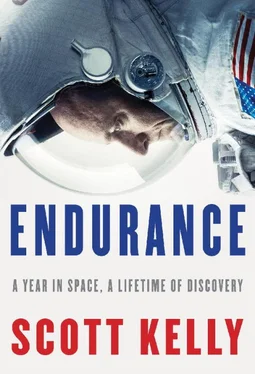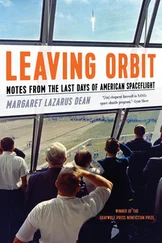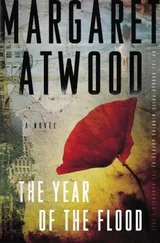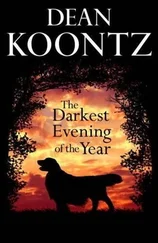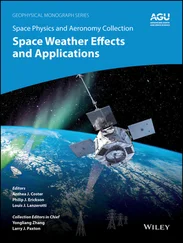STS-118 was a mission to deliver a number of key components to the International Space Station: a small truss segment, an external stowage platform, and a new control moment gyroscope, a device that allows the station to control its attitude. We were also to carry a SPACEHAB logistics module, which was packed with supplies to bring up to the station. When it returned, it would carry science samples, broken hardware, and garbage back down. We would be flying the sixth mission after the loss of Columbia, and several of the subsequent missions had withstood damage to the heat tiles from debris falling during launch. Each time, engineers examined the damage and determined anew how to avoid it, but then it would happen again. I would have preferred that tiles not be damaged, of course, but I was glad the issue was being taken seriously now, and it seemed to me we were doing everything we could to mitigate the risk.
The crew assignments for this flight were now finalized: Scorch, Rick Mastracchio, Barbara Morgan, Dave Williams, Tracy Caldwell, and, late in our training, Alvin Drew.
Barbara Morgan had been an elementary school teacher in Idaho when she was named a finalist for the Teacher in Space program in 1985. When Christa McAuliffe was chosen to teach lessons from space on Challenger, Barbara was designated her backup. She trained along with Christa and the Challenger crew for the entire year, preparing to complete the mission if for some reason Christa wasn’t able to. After the traumatic experience of seeing Challenger explode in the sky over Florida with seven good friends aboard, a lot of people would have distanced themselves from that tragedy. But to her credit, Barbara volunteered to go on the national tour that had been planned for Christa after the mission, visiting schools all over the country to talk about the space shuttle and the importance of education. Barbara wanted the schoolchildren to hear from someone who had shared Christa’s dream of flying in space and still had faith in the space program. Barbara officially joined the astronaut corps in 1998 and worked in a number of positions before being assigned to her first flight—this flight with me. When she flew in space, it would be twenty-one years after the Challenger disaster.
Barbara was also the only astronaut to have been chosen for the corps completely outside the process of the astronaut selection board. For this reason, some of our colleagues regarded her with skepticism. I decided to reserve judgment until I got to know her better, and I’m glad I did. Simply put, Barb worked her ass off. She mastered every facet of her job and became a valued member of my crew, exceeding my expectations.
Dave Williams was a Canadian astronaut who worked as an ER doctor in his previous life. He is proud of his Welsh heritage and was the first person to broadcast from space in the Welsh language on his first space shuttle mission. Dave was completely unflappable.
Tracy Caldwell was flying her first mission. NASA selected Tracy when she was twenty-nine, right out of her Ph.D. program in chemistry. She looked young for her age, so she was treated as a bit of a kid by many of our astronaut colleagues, but her performance was top-notch. She was conscientious, incredibly detail oriented, and serious, but also fun to be around. Tracy turned thirty-eight on the sixth day of our mission.
Alvin Drew was assigned to the mission just three months before the flight. He flew helicopters in combat for the Air Force in their Special Operations Command and then went on to become a helicopter test pilot. He was not easily fazed and didn’t seem thrown off by having been assigned to this flight so late, though it meant he would be constantly struggling to catch up.
For me, training to fly as commander was a completely new challenge. I had to learn my own role, as well as take responsibility for my crew—making sure everyone knew his or her job, recognizing each crew member’s strengths and weaknesses, pulling us together as a team, and mentoring the rookies. Because we would have three first-time space flyers on our crew (Barb, Tracy, and Alvin), we were one of the least-experienced crews in shuttle history, with only four previous flights among the seven of us.
We went into quarantine in Houston ten days before launch, then flew to Florida and continued our quarantine there for the last four days. There is a NASA tradition, which some crews follow more closely than others, of pulling pranks on rookies. When the Astrovan pulled up to the launchpad, I said offhandedly to Tracy, Barb, and Alvin, “Hey, you guys remembered to bring your boarding passes, right?” They looked at one another quizzically as the four of us veterans pulled preprinted boarding passes out of our pockets.
“Don’t tell me you didn’t bring your boarding passes! They won’t let you on the space shuttle without one!” I insisted. After an initial look of panic crossed their faces, the three rookies quickly caught on.
The closeout crew helped us get strapped into our seats, then climbed out of the shuttle and closed the hatch. Or tried to. The shuttle launch director announced that they couldn’t tell whether our hatch was properly closed or not.
The shuttle hatch had presented problems before. The closeout crew, who knew the equipment better than anyone, felt it was closing properly, but no one wanted to risk our lives on that hunch. They shut the hatch, opened it again, shut it again, opened it again. We were all strapped tightly into our seats and couldn’t see the hatch to give the closeout crew a visual confirmation. We were running out of time in our launch window.
Eventually Rick Mastracchio, who could stretch himself to see the hatch from his center seat on the flight deck, announced that the hatch was closed but that we now had an eighth crew member. One of the closeout crew had come into the space shuttle with us to inspect all the dogs—the bolts that attach the hatch to the surrounding structure—while the hatch was closed. He was able to confirm that it was working properly, and then the hatch was opened again so he could jump out. An ingenious and practical solution, and one I hadn’t thought of myself.
—
THIS TIME I knew what to expect at launch, so I could enjoy it a little more, even looking out the window a bit. It had been nearly eight years since I last flew, and the sheer instantaneous power was still indescribable, the horizon pulling away faster than would seem possible. We reached orbit safely and, as on my previous mission, successfully got through the arduous job of turning the rocket ship into a spaceship.
Before I went to sleep, I got an email from the lead shuttle flight director telling me that nine pieces of foam had come off the external tank, three of which they thought had struck the thermal protection system on the bottom of the orbiter, similar to what had doomed Columbia —though in Columbia ’s case, the damage was on the more critical reinforced carbon-carbon insulation on the leading edge of the wing. NASA didn’t think it was a big deal—foam strikes could frequently be harmless—but were just letting me know out of an abundance of caution.
The next day, we conducted an inspection of the underside of the shuttle using a camera and laser scanners on the end of a boom attached to the robotic arm in an effort to pinpoint the damage. The images didn’t reveal anything conclusive. We approached ISS the next day and flew the orbiter through a 360-pitch maneuver, a backflip to point the shuttle’s heat shield so the station crew could capture up-close pictures. The photos showed an area of interest on a critical part of the belly of the orbiter near the right landing gear door; it was sizable enough that NASA decided to do a more focused inspection with the boom laser system after we docked. That inspection revealed a hole, about three inches by three inches, that went all the way through the silica thermal protection tiles down to the underlying felt.
Читать дальше
